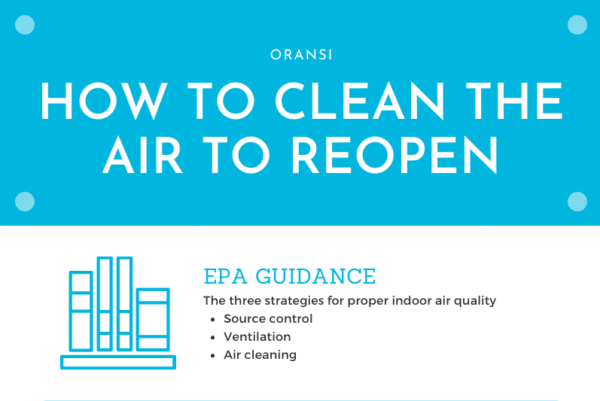Experts agree that ventilation in schools is inadequate and many administrators seek clarification regarding best practices to improve classroom air quality and reduce infectious disease transmission.
School administrators continue to struggle with selecting the right ventilation system for classrooms, as more states reopen schools for in-person learning. The U.S.-based air purification company, Oransi, offers the following guidance for schools that will allow them to select the right ventilation products, the first time, thereby helping to avoid any delay when reopening.
To achieve good indoor air quality the Environmental Protection Agency (EPA) states there are three strategies:
1) source control (removes the source of the pollutant),
2) ventilation (brings in fresh air from outdoors)
3) and air cleaning (through use of an air purifier).
For school ventilation there are two options: a HEPA air filtration system or an HVAC ventilation system. Knowing which option is right for a school depends on the efficiency (percentage of particles of a given size that are removed by the air filter with each air pass) and if enough air is moving for the room size.
Commercial HVAC systems are expensive, time-consuming to upgrade, and generally use lower efficiency air filters that do not remove fine particles such as viruses – allowing them to pass back into a room’s air. However, upgrading or installing an HVAC system is the right solution if there is a very large space to clean – usually larger than 1,500 square feet – and removing viruses or fine particles is not a concern. But a new HVAC system may not be realistic when a school’s budget is limited or the campus buildings are older and source control and proper ventilation cannot be achieved. In this case, HEPA air purifiers may be the best supplemental solution for a school’s budget and layout.
But how can schools select the right HEPA air purifier? Oransi offers the following tips:
1) Based on the recommendation of Harvard University School of Public Health, look for 5 air changes per hour (ACH). If a school’s existing Commercial HVAC system provides 3 ACH, then the air purifier selected would need to provide 2 ACH as a supplement.
2) Look for a portable air purifier with a HEPA filter.
3) Look for a high Clean Air Delivery Rate (CADR). This represents the volume of clean air coming from an air purifier. The air must be cleaned quickly in order to remove virus particles. Only a HEPA filter can capture a virus with the proper air flow.
4) Avoid add-ons such as ionizers or UV lights – a technology that requires a lengthy contact time to remove viruses and airborne particles.
5) Know the exact square footage of the classroom the air purifier will be placed in. To calculate square footage, measure the length and width of the classroom in feet, and then multiply the two numbers to get the square footage. Also calculate in the ceiling height, as an 8-foot ceiling is often assumed. Then refer to the CADR rating to determine what size air purifier can clean the room.
For help selecting air purifiers for a school, visit https://oransi.com/pages/air-purifiers-for-schools or email schools (at) oransi.com or call 888-281-3948.
- SchoolStatus Launches SchoolStatus Boost, an Innovative Educator Development Solution for Enhanced Teacher Growth and Development - April 22, 2024
- Frontline Education Releases Inaugural K-12 Lens Survey Report To Guide K-12 Decision-Making - April 20, 2024
- Arizona’s Apache Junction Unified School District Supports Innovative Teaching and Learning with New EdTech Resources - April 19, 2024


